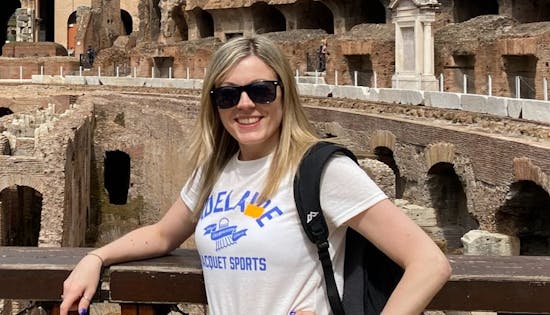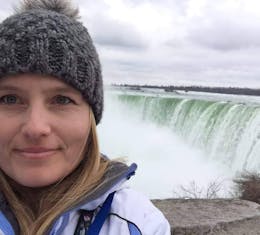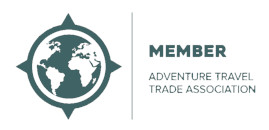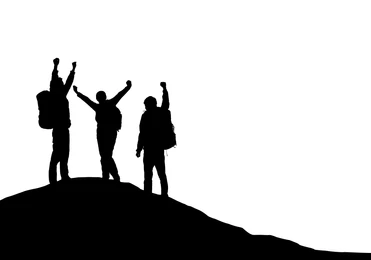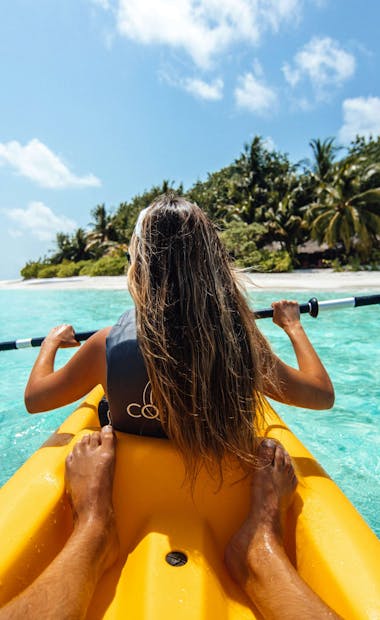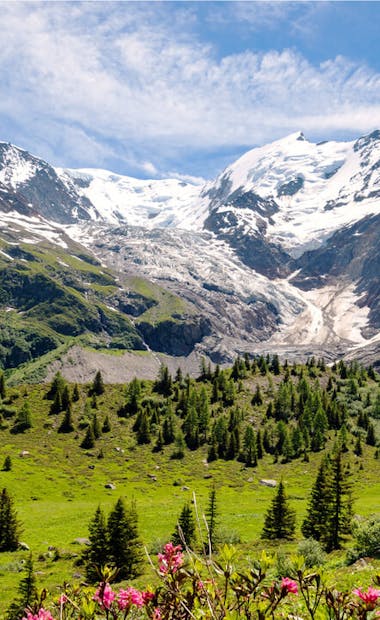
Tour Du Mont Blanc
Explore our trekking adventures for Europe's most famous peak
Popular tours
- Save1%
 View Tour
View TourHike the Tour du Mont Blanc - 8 Days
- Chamonix-Mont-Blanc to Chamonix-Mont-Blanc
- Age group: 15 - 99
- Max group size: 12
Was:£3,030From£3,000 - Save2%
 View Tour
View TourHighlights of Mont Blanc - 8 Days
- Les Houches to Les Houches
- Age group: 16 - 79
- Max group size: 16
Was:£1,865From£1,837 - Save1%
 View Tour
View TourTrekking Mont Blanc - 10 Days
- Chamonix-Mont-Blanc to Chamonix-Mont-Blanc
- Age group: 12 - 100
- Max group size: 12
Was:£1,799From£1,781
Tour Du Mont Blanc
Embark on an epic adventure in the heart of the majestic Alps with the Tour du Mont Blanc. This legendary trekking route is a dream come true for outdoor enthusiasts and nature lovers seeking an unforgettable experience. In this rugged and awe-inspiring landscape, you'll witness breath-taking panoramas, traverse charming alpine villages, and challenge yourself on the renowned Mont Blanc circuit. Join us on this exhilarating journey as we delve into the wonders of the Tour du Mont Blanc.
The Tour du Mont Blanc is a renowned long-distance hiking trail that encircles the mighty Mont Blanc massif, stretching across three countries: France, Italy, and Switzerland. This iconic route covers approximately 170 kilometres (105 miles) and takes you through some of the most pristine and breath-taking alpine scenery in the world.
As you embark on this multi-day trek, you'll encounter snow-capped peaks, verdant valleys, crystal-clear lakes, and cascading glaciers at every turn. The trail meanders through picturesque villages, where you can immerse yourself in the local culture, indulge in delicious regional cuisine, and experience the warm hospitality of mountain communities.
The Tour du Mont Blanc offers a range of options for trekkers of different abilities and preferences. Whether you're an experienced hiker seeking a challenging adventure or a nature enthusiast looking to soak in the awe-inspiring beauty, there are variations of the route to suit your needs. The entire circuit typically takes around 10 to 12 days to complete, with daily stages averaging between 10 and 20 kilometres (6 to 12 miles).
Along the way, you'll encounter iconic landmarks such as the Col de la Seigne, Col du Bonhomme, and the famous Grand Balcon Sud trail, offering panoramic views of towering peaks, glacial valleys, and alpine meadows painted with vibrant wildflowers.
While the Tour du Mont Blanc is a physically demanding trek that requires a moderate level of fitness, the rewards are unparalleled. Each day brings new discoveries, from the tranquillity of secluded mountain refuges to the camaraderie shared among fellow trekkers from around the world.
It's essential to come prepared with sturdy hiking gear, proper clothing for varying weather conditions, and a spirit of adventure. The route is well-marked, ensuring you can navigate the trail with ease, but it's always recommended to carry a detailed map or guidebook to enhance your experience.
Whether you embark on this incredible journey independently or choose to join a guided tour, the Tour du Mont Blanc promises an immersive and unforgettable experience. So lace up your boots, breathe in the crisp mountain air, and let the magic of the Mont Blanc massif envelop you as you embark on this legendary trekking adventure.
Book your Tour du Mont Blanc expedition with us today and let us guide you to the pinnacle of alpine exploration. Get ready to create lifelong memories and forge a deep connection with nature on this extraordinary journey through the iconic Mont Blanc circuit.
When is the best time to trek Tour Du Mont Blanc?
The best time to trek the Tour du Mont Blanc is typically during the summer months, from late June to early September. This period offers the most favourable weather conditions and optimal trail accessibility. However, it's important to keep in mind that weather in the mountains can be unpredictable, and conditions can vary from year to year. Here's a breakdown of the seasons to help you plan your trek:Summer (June to September): This is the peak trekking season for the Tour du Mont Blanc. During these months, the weather is generally mild and pleasant, with temperatures ranging from 10°C to 25°C (50°F to 77°F) at lower elevations. The trails are usually clear of snow, and mountain refuges, campsites, and services along the route are open. The days are longer, providing ample daylight for hiking, and you'll have the opportunity to witness beautiful wildflowers in bloom.
Spring (May to June): The spring season can be a lovely time to trek the Tour du Mont Blanc, as the landscape begins to awaken from winter. However, it's important to note that snow can still be present at higher elevations, and some mountain passes may not be fully accessible. The weather can be more variable, with the possibility of rain or even late snowfalls. It's recommended to check trail conditions and consult with local authorities before embarking on the trek during this period.
Autumn (September to October): Autumn offers a quieter and more serene experience on the Tour du Mont Blanc. The weather is generally cooler, with temperatures ranging from 5°C to 20°C (41°F to 68°F). The trails are less crowded, and accommodations may be more readily available. However, it's important to be prepared for changing weather conditions, including cooler temperatures, potential rainfall, and the possibility of early snowfall at higher elevations.
It's worth noting that while summer is the most popular time for trekking the Tour du Mont Blanc, it can also be the busiest. If you prefer a quieter experience and don't mind slightly cooler temperatures, spring and autumn can offer a more peaceful and immersive journey.
Ultimately, the best time to trek the Tour du Mont Blanc depends on your preferences, hiking experience, and tolerance for varying weather conditions. Regardless of the season, it's always advisable to check weather forecasts, trail conditions, and consult with local authorities or experienced guides to ensure a safe and enjoyable trek.
How challenging is the Tour du Mont Blanc?
The Tour du Mont Blanc is considered a challenging trek that requires a good level of physical fitness and hiking experience. The difficulty level can vary depending on factors such as your fitness level, hiking pace, and the specific route options you choose. Here are some aspects to consider when assessing the challenge of the Tour du Mont Blanc:
Distance and Duration: The complete Tour du Mont Blanc route covers approximately 170 kilometres (105 miles) and typically takes around 10 to 12 days to complete. This involves hiking an average of 15 to 20 kilometres (9 to 12 miles) per day. The duration and daily distance can be physically demanding, especially when combined with significant elevation gains and losses.
Elevation Gain and Loss: The trek involves substantial elevation changes as you ascend and descend through mountain passes and valleys. The total elevation gain during the trek can range from 10,000 to 12,000 meters (32,800 to 39,370 feet) over the course of the entire route. This can put a strain on your muscles and require stamina and endurance.
Steep and Technical Sections: The route includes steep and rugged sections, especially when crossing mountain passes and traversing challenging terrain. Some parts may involve scrambling, uneven surfaces, or exposed sections that require caution and surefootedness.
Weather Conditions: Weather conditions can add to the challenge of the trek. The Tour du Mont Blanc is typically done during the summer months, but weather in the mountains can be unpredictable. You may encounter rain, wind, or even snow, particularly at higher elevations. It's important to be prepared for changing weather conditions and adjust your plans accordingly.
Fitness and Preparation: Prior physical fitness and hiking experience are beneficial for tackling the Tour du Mont Blanc. Building endurance through regular cardiovascular exercise, strength training, and hiking practice can help prepare your body for the demands of the trek. It's also advisable to do some pre-trek conditioning and hike with a backpack to get accustomed to carrying the necessary gear.
Altitude Considerations: While the Tour du Mont Blanc does not involve extremely high altitudes, there are sections that reach elevations of over 2,500 meters (8,200 feet). It's essential to acclimatize properly, stay hydrated, and be aware of any signs of altitude-related illnesses.
It's important to assess your personal fitness level, hiking experience, and comfort with challenging terrain before undertaking the Tour du Mont Blanc. Some hikers choose to hire experienced guides or join organized trekking groups to ensure safety and guidance along the route. Proper preparation, including physical training, gear selection, and knowledge of the route, will contribute to a more enjoyable and successful trek.
How fit do I need to be to trek the Tour Du Mont Blanc?
Trekking the Tour du Mont Blanc requires a moderate to high level of fitness. While it is not a technical climb, the trail encompasses significant elevation gains and losses, varying terrain, and long hiking days. It's important to be adequately prepared physically and mentally to fully enjoy the experience. Here are some factors to consider regarding fitness:
Endurance: The Tour du Mont Blanc is a multi-day trek covering approximately 170 kilometres (105 miles) with daily stages averaging between 10 and 20 kilometres (6 to 12 miles). Building endurance is crucial, as you'll be hiking for several consecutive days, often with steep ascents and descents. Prioritizing cardiovascular exercises such as hiking, walking, running, or cycling will help build stamina.
Strength: Trekking in mountainous terrain requires leg strength and stability. Strengthening your leg muscles, particularly the quadriceps and calves, through exercises like squats, lunges, and stair climbing, can help prepare your body for the demands of the trail. Core exercises are also beneficial for stability and balance.
Hill and Stair Training: The Tour du Mont Blanc involves significant elevation changes, including steep ascents and descents. Incorporating hill and stair training into your fitness routine will help prepare your muscles and cardiovascular system for these challenging sections. Seek out hilly trails or use staircases for targeted training.
Backpack Conditioning: Carrying a backpack adds an additional physical demand to your trek. Gradually increase the weight of your backpack during training to simulate the load you'll be carrying on the Tour du Mont Blanc. This will help your body adapt to the extra weight and build strength.
Mental Preparedness: Trekking the Tour du Mont Blanc requires mental resilience. Be prepared for long days, potentially challenging weather conditions, and the physical exertion involved. Building mental strength and a positive mindset will help you overcome obstacles and fully appreciate the experience.
It's advisable to start training well in advance of your trek, ideally a few months beforehand, to allow your body to adapt and gradually build up your fitness level. Consulting with a fitness professional or a qualified hiking guide can provide personalized advice and training recommendations based on your current fitness level and goals.
Remember to listen to your body during the trek, pace yourself, and take breaks as needed. Taking time to acclimatize to the altitude and allowing for rest days along the route can also contribute to an enjoyable and successful trek.
By adequately preparing and being committed to your fitness training, you'll increase your chances of having a rewarding and memorable experience on the Tour du Mont Blanc.
How much walking do we do each day on the Tour Du Mont Blanc?
The amount of walking you'll do each day on the Tour du Mont Blanc can vary depending on the specific itinerary you choose and your personal pace. The route is typically divided into stages, and the distance covered per day can range from 10 to 20 kilometres (6 to 12 miles). It's important to note that these distances are approximate, and actual distances may vary slightly based on the specific trails taken and any detours or side trips you choose to explore.
On average, you can expect to walk for approximately 6 to 8 hours per day, including rest breaks and time for enjoying the scenery. The duration of each stage can depend on factors such as elevation gain and loss, the condition of the trail, and your own fitness level and hiking pace. Some sections may involve more challenging terrain or steep ascents and descents, which can affect your walking speed and overall time.
It's important to keep in mind that the Tour du Mont Blanc is not a race, and it's essential to listen to your body, take breaks when needed, and set a pace that is comfortable for you. The focus should be on enjoying the stunning landscapes, immersing yourself in the experience, and appreciating the journey rather than rushing through it.
It's also worth mentioning that there are several accommodation options along the route, including mountain refuges, hotels, and guesthouses. Choosing a particular itinerary or guided tour will determine the daily distances and stages planned for you, allowing you to have a clear idea of the walking involved each day.
Ultimately, the amount of walking you do each day on the Tour du Mont Blanc will depend on your chosen itinerary, personal pace, and any variations you make along the way. It's always a good idea to consult detailed maps, guidebooks, or experienced guides to get a more precise understanding of the distances and walking times for your specific trek.
What should I pack for a Tour Du Mont Blanc trek?
Packing the right gear and essentials for your Tour du Mont Blanc trek is crucial to ensure comfort, safety, and enjoyment throughout your journey. Here's a comprehensive list of items to consider when packing for your trek:
Clothing:
- Lightweight, moisture-wicking shirts and pants for hiking
- Insulating layers such as fleece or down jacket for cooler temperatures
- Waterproof and breathable jacket and pants for protection against rain and wind
- Hiking socks (preferably wool or synthetic) for moisture management and blister prevention
- Sturdy and comfortable hiking boots with ankle support
- Hat or cap for sun protection
- Gloves and a warm hat for colder sections or higher elevations
Backpack and Trekking Gear:
- Backpack with a capacity of around 35-45 litres to carry your gear and supplies
- Trekking poles for stability and to reduce strain on knees during descents
- Water bottle or hydration system to stay hydrated along the trail
- Headlamp or flashlight with extra batteries for any early morning or late evening hikes
- Sunglasses with UV protection
Sleeping Gear:
- Lightweight and compact sleeping bag suitable for mountain huts or refuges
- Travel pillow or inflatable pillow for added comfort
Toiletries and Personal Care:
- Travel-sized toiletries (toothbrush, toothpaste, biodegradable soap, etc.)
- Microfiber towel for quick drying
- Sunscreen with high SPF
- Lip balm with SPF
- Insect repellent for areas with mosquitoes or bugs
- Personal medications and any necessary prescriptions
First Aid Kit:
- Basic first aid supplies such as adhesive bandages, blister pads, antiseptic ointment, and pain relievers
- Any personal medications or specific medical supplies you may require
Miscellaneous Items:
- Map and guidebook or GPS device for navigation
- Cash in the local currency for purchasing meals, snacks, and supplies along the way (credit cards may not always be accepted)
- Mobile phone and charger (consider bringing a portable power bank for charging on the go)
- Lightweight and quick-drying towel or sarong
- Waterproof bags or stuff sacks to keep your gear organized and protected from rain
- Extra plastic bags for storing wet or dirty clothes
- Camera or smartphone to capture the stunning landscapes and memories
It's essential to pack light and only bring the essentials, as you'll be carrying everything with you throughout the trek. Remember to consider the weight and size of your gear to ensure it fits comfortably in your backpack.
Additionally, check the weather forecast for your trekking dates and pack accordingly. Weather in the mountains can be unpredictable, so it's wise to be prepared for various conditions, including rain and cooler temperatures at higher elevations.
Lastly, if you plan to stay in mountain huts or refuges along the route, it's advisable to check their specific requirements or amenities in advance to ensure you have everything you need for a comfortable stay.
By packing the right gear and essentials, you'll be well-prepared to tackle the Tour du Mont Blanc and fully immerse yourself in the stunning landscapes and rewarding experiences that await you along the way.
Who typically treks the Tour Du Mont Blanc?
The Tour du Mont Blanc attracts a diverse range of trekkers from all over the world. It appeals to outdoor enthusiasts, nature lovers, and those seeking a memorable adventure in the stunning Alpine scenery. Here are some groups of people who typically embark on the Tour du Mont Blanc:
Hiking and Nature Enthusiasts: The Tour du Mont Blanc is a dream come true for those who love exploring the great outdoors. It attracts individuals who enjoy immersing themselves in nature, appreciating breath-taking landscapes, and challenging themselves physically.
Experienced Trekkers: The trek is often sought after by experienced hikers and trekkers who have previously tackled other long-distance trails. These individuals may be looking for a new and exciting adventure or consider the Tour du Mont Blanc as one of their bucket-list treks.
International Travelers: The Tour du Mont Blanc draws trekkers from all corners of the globe. Travelers from Europe, North America, Asia, and beyond are captivated by the allure of the iconic Mont Blanc massif and the opportunity to explore multiple countries on one trek.
Solo Travelers: The Tour du Mont Blanc is well-suited for solo travellers who seek a sense of independence, adventure, and the opportunity to meet fellow hikers from different backgrounds. The route offers a chance to connect with like-minded individuals and create new friendships along the trail.
Small Groups or Friends: Many people choose to trek the Tour du Mont Blanc as part of a small group or with a few close friends. This allows for shared experiences, camaraderie, and the opportunity to support and motivate each other throughout the journey.
It's important to note that while the Tour du Mont Blanc attracts a wide range of trekkers, it does require a certain level of fitness and preparation. It's advisable to have prior hiking experience and be in good physical condition to fully enjoy the trek.
The diversity of trekkers on the Tour du Mont Blanc contributes to a vibrant and inclusive atmosphere along the route. Sharing stories, experiences, and the common goal of completing this remarkable journey often leads to lasting memories and a sense of accomplishment.
Whether you're an avid hiker, a nature enthusiast, or someone seeking an extraordinary adventure, the Tour du Mont Blanc offers a unique and unforgettable experience for a wide range of individuals from different walks of life.
How does the rooming work on tours?
Small group tours in Tour Du Mont Blanc typically involve a set itinerary where you travel with a group of fellow travellers and a tour leader/guide. Accommodation arrangements vary depending on the specific tour you choose. Here are some common aspects of rooming arrangements on small group tours:
Shared Rooms: In order to promote camaraderie and facilitate interaction among group members, most tours arrange shared accommodation. This means you will be paired with another member of the same gender from the group to share a room. Roommates may sometimes change periodically throughout the tour.
Single Supplement: If you prefer to have your own room and privacy, you may have the option to pay a single supplement fee. This additional fee allows you to have your own room for the duration of the tour. However, please note that single supplements can vary in cost and availability.
Roommate Matching: Tour operators usually offer roommate matching services, where they try to pair you with a suitable roommate based on your preferences, such as age range. This can help ensure compatibility and a more enjoyable experience for all participants.
Rooming Preferences: When booking your small group tour, it's important to communicate your rooming preferences to the tour operator. If you have specific requirements or preferences, such as sharing with a friend or a specific roommate request, it's advisable to inform the tour operator during the booking process.
It's important to carefully read the tour details and inclusions provided by the tour operator to understand their specific rooming policies. If having your own room is a priority, make sure to inquire about the availability of single supplements and any associated costs before booking your tour.
Keep in mind that while sharing a room with a fellow traveller can be a great way to meet new people and build connections, having your own room provides more privacy and flexibility. Consider your preferences and the dynamics of the tour when deciding whether to opt for a shared room or pay for a single supplement.
Remember to communicate your needs and preferences clearly with the tour operator during the booking process to ensure a comfortable and enjoyable accommodation experience on your small group tour in Tour Du Mont Blanc.
Where is Mont Blanc?
Mont Blanc, also known as Monte Bianco in Italian, is located in the Alps mountain range. It straddles the border between France and Italy, with the summit being shared by both countries. Mont Blanc is situated in the Graian Alps and is part of the Mont Blanc massif, which includes several other prominent peaks.
The mountain is specifically located in the Aosta Valley region of Italy and the Haute-Savoie department of France. It is approximately 15 kilometres (9 miles) south-southwest of the town of Chamonix-Mont-Blanc in France and about 15 kilometres (9 miles) east-northeast of Courmayeur in Italy.
With an elevation of 4,808.73 meters (15,777 feet), Mont Blanc is the highest mountain in the Alps and the highest peak in Western Europe. It is renowned for its majestic beauty, challenging climbing routes, and its status as an iconic symbol of the region.
Many trekkers on the Tour du Mont Blanc have the opportunity to admire Mont Blanc's grandeur and awe-inspiring presence as they traverse the surrounding trails and valleys, offering unparalleled views and an unforgettable experience in the heart of the Alps.
What is the food like when trekking the Tour Du Mont Blanc?
When trekking the Tour du Mont Blanc, you'll have the opportunity to savour a variety of delicious and hearty cuisines along the route. The culinary experiences you'll encounter will be influenced by the local traditions of the three countries encompassed by the trek: France, Italy, and Switzerland. Here's an overview of the food you can expect to enjoy during your journey:
French Cuisine: In the French sections of the trek, you'll encounter classic dishes that reflect the rich culinary heritage of the region. Look forward to indulging in rustic French cuisine, which often includes:
Savoury Cheese: France is renowned for its incredible cheese varieties. Be sure to try the local specialties such as Beaufort, Comté, Tomme de Savoie, and Reblochon.
Charcuterie: French charcuterie, including cured meats like sausages, ham, and pâté, is a common feature in meals and picnics.
Tartiflette: A comforting dish made with potatoes, reblochon cheese, onions, and bacon—a perfect meal to refuel after a day of hiking.
Raclette: Melted raclette cheese served with boiled potatoes, pickles, and cured meats—an Alpine favourite.
Crêpes and Galettes: Thin pancakes filled with sweet or savoury fillings, such as Nutella, sugar, ham, or cheese, respectively.
Italian Cuisine: As you venture into the Italian sections, you'll encounter the flavours of traditional Italian cuisine, which includes:
Pasta and Risotto: Italy is known for its pasta and risotto dishes. Enjoy plates of spaghetti, tagliatelle, or risotto prepared with local ingredients, sauces, and flavours.
Pizza: In the Italian towns along the route, you may find pizzerias serving mouth-watering pizzas with various toppings to satisfy your cravings.
Gelato: Treat yourself to some gelato, the classic Italian ice cream, available in a multitude of flavours. It's a perfect way to cool down after a long day of hiking.
Espresso and Cappuccino: Don't miss the chance to savour a freshly brewed Italian espresso or indulge in a creamy cappuccino at a local café.
Swiss Cuisine: The Swiss portion of the trek introduces you to Swiss culinary delights, which can include:
Swiss Cheese: Switzerland is famous for its cheese, and you'll find a wide variety of flavourful cheeses, such as Gruyère and Emmental.
Fondue: Switzerland is synonymous with fondue, a communal dish where you dip pieces of bread into melted cheese. It's a delightful and sociable culinary experience.
Rösti: This traditional Swiss dish consists of grated and fried potatoes, often served as a side dish or as a main course with various toppings.
Swiss Chocolate: Switzerland is renowned for its high-quality chocolate. Treat yourself to some delectable Swiss chocolates available in local shops.
During the trek, you'll come across mountain refuges, cosy restaurants, and charming cafés where you can enjoy these regional specialties. It's worth noting that the availability of food options may vary depending on the season and the specific villages or towns you pass through.
Be sure to try the local specialties and flavours as part of your Tour du Mont Blanc experience. The combination of French, Italian, and Swiss cuisine adds an extra layer of cultural richness to your trek, making it a memorable culinary journey alongside the stunning natural beauty of the Alps.
Is water available during the Tour du Mont Blanc?
Yes, water is generally available during the Tour du Mont Blanc trek. Along the route, you'll come across several opportunities to refill your water bottles and stay hydrated. Here's some information to help you plan your water supply during the trek:
Natural Water Sources: The Tour du Mont Blanc takes you through mountainous terrain where you'll encounter streams, rivers, and alpine springs. These natural water sources provide fresh, clean water that is safe to drink. You can use a water purification method, such as a water filter or purifying tablets, to ensure the water is free from any potential contaminants.
Mountain Refuges and Villages: Throughout the trek, you'll pass by mountain refuges, villages, and towns where you'll have access to amenities, including water sources. Many refuges and accommodations along the route have facilities for refilling water bottles. Additionally, you can find public fountains or taps in villages where you can replenish your water supply.
Carry Sufficient Water: It's essential to carry enough water to sustain you between water sources, especially during longer stretches without refilling opportunities. Depending on the distance between water points and the weather conditions, plan to carry at least 1-2 litres of water per person to stay properly hydrated during each segment of the trek.
Plan for Remote Sections: There are certain sections of the Tour du Mont Blanc that are more remote and have limited access to water sources. It's crucial to plan ahead and ensure you have enough water to last through these sections. Consult maps, guidebooks, or local authorities to identify these areas and make necessary arrangements.
Consider a Water Bladder or Hydration System: To ensure easy access to water while trekking, many hikers find it convenient to use a water bladder or hydration system that fits inside their backpack. These systems have a tube and bite valve that allows you to drink water on the go without having to stop and retrieve a water bottle.
Remember, staying properly hydrated is vital while trekking, particularly in mountainous terrain. Make sure to drink water regularly throughout the day, even if you don't feel particularly thirsty. It's also a good idea to start each day with a full water supply.
By planning ahead, utilizing natural water sources, and taking advantage of refill opportunities, you can ensure you have enough water to stay hydrated and enjoy the Tour du Mont Blanc safely.
Is there a wifi signal on the Tour du Mont Blanc?
While the Tour du Mont Blanc takes you through breath-taking natural landscapes, it's important to note that access to Wi-Fi signals can be limited or intermittent along the route. Here are a few points to consider regarding Wi-Fi availability during the trek:
Mountain Refuges and Accommodations: Some mountain refuges and accommodations along the Tour du Mont Blanc may offer Wi-Fi access, but the availability and reliability of the connection can vary. In certain cases, Wi-Fi may only be accessible in common areas such as dining rooms or reception areas rather than in individual rooms or tents.
Villages and Towns: As you pass through villages and towns along the route, you may find cafes, restaurants, or accommodations that offer Wi-Fi access to customers. However, keep in mind that the connection speed and availability can vary depending on the location and the establishment.
Limited Connectivity in Remote Areas: The Tour du Mont Blanc covers remote and mountainous regions, where the infrastructure for telecommunications can be limited. In these areas, finding a reliable Wi-Fi signal may be challenging or even non-existent.
Mobile Data Coverage: Mobile data coverage along the trek can also be limited, especially in more remote sections and at higher elevations. Depending on your mobile network provider and their coverage in the region, you may experience intermittent or no data connection.
Given the natural and rugged nature of the trek, many hikers embrace the opportunity to disconnect from the digital world and fully immerse themselves in the stunning surroundings. However, if staying connected is essential, it's recommended to plan ahead and make necessary arrangements, such as downloading maps or important information offline before the trek.
It's always a good idea to check with accommodations or local authorities along the route to inquire about Wi-Fi availability and make any necessary arrangements in advance.
Is there a phone signal on the Tour du Mont Blanc?
The Tour du Mont Blanc covers a diverse range of landscapes, including remote mountainous regions. As a result, the availability and strength of mobile phone signals can vary along the route. Here are a few points to consider regarding phone signal during the trek:
Mobile Network Coverage: The trek passes through different countries, including France, Italy, and Switzerland. The availability and coverage of mobile networks can differ between these countries and even within specific regions. Major towns and villages along the route generally have better mobile network coverage compared to more remote areas.
Intermittent Signal: In mountainous and remote regions, it's common to experience intermittent or weak mobile phone signals. Signal strength can be affected by factors such as the topography, weather conditions, and the distance from cellular towers.
High Elevation Areas: In certain sections of the trek that involve higher elevations or deep valleys, you may encounter limited or no mobile phone signal. This is especially true in more remote and isolated areas where the infrastructure for telecommunication is limited.
Emergency Signal: While regular phone signal may be limited, it's important to note that emergency signals for emergency services (such as emergency calls to local authorities) are prioritized and usually have better coverage. In case of an emergency, it's advisable to know the emergency contact numbers of the respective countries and the local mountain rescue services.
Satellite Phones: If you require consistent communication during the trek, especially in remote areas, you may consider carrying a satellite phone. Satellite phones can provide more reliable communication options in areas where regular mobile networks are inaccessible.
It's important to manage your expectations regarding phone signal availability along the Tour du Mont Blanc. Embrace the opportunity to disconnect from constant connectivity and immerse yourself in the natural beauty of the surroundings. If necessary, plan your communication needs accordingly, inform your loved ones about potential communication gaps, and prioritize safety and emergency preparedness during the trek.
Is the Tour du Mont Blanc safe?
The Tour du Mont Blanc is generally considered a safe trek, but it's important to be aware of certain factors and take necessary precautions to ensure your safety. Here are some key points to keep in mind:Weather Conditions: The weather in mountainous regions can be unpredictable and change rapidly. It's important to stay informed about weather forecasts before and during your trek. Be prepared for varying conditions, including rain, wind, and even snow, particularly at higher elevations. Adjust your plans accordingly and ensure you have appropriate clothing and gear to stay comfortable and safe.
Terrain and Trail Conditions: The Tour du Mont Blanc involves hiking through diverse terrain, including steep ascents, descents, rocky paths, and potentially exposed sections. Pay attention to trail markings, follow designated paths, and exercise caution in more challenging areas. Use proper hiking footwear, trekking poles for stability, and consider wearing a helmet in more technical sections if necessary.
Physical Fitness and Health: The Tour du Mont Blanc requires a good level of physical fitness and endurance. Assess your own fitness level and consult with a healthcare professional if you have any pre-existing medical conditions. Stay hydrated, carry necessary medication and first aid supplies, and listen to your body throughout the trek. Take breaks when needed and don't push yourself beyond your limits.
Emergency Preparedness: Familiarize yourself with emergency procedures and contact information for mountain rescue services in the regions you'll be trekking through. Carry a fully charged mobile phone with emergency numbers programmed, as well as a map, compass, and/or GPS device. Let someone know your itinerary and estimated return times.
Wildlife and Natural Hazards: The Tour du Mont Blanc is home to a variety of wildlife, including birds, mountain goats, and marmots. Respect their natural habitat, do not approach or disturb them, and follow any local guidelines regarding wildlife encounters. Be cautious of natural hazards such as loose rocks, falling debris, or slippery surfaces, especially during inclement weather.
Accommodations and Services: The trek passes through villages, towns, and mountain refuges where you can find accommodations, food, and supplies. However, it's important to note that services and amenities may vary, especially in more remote areas. Plan your itinerary and ensure you have necessary provisions, such as food, water, and appropriate gear, for stretches between services.
By being prepared, staying informed, and using common sense, you can enhance your safety during the Tour du Mont Blanc. It's always advisable to do thorough research, consult local authorities or experienced guides, and exercise caution while enjoying the stunning landscapes and outdoor adventure.
Book With Confidence
Monthly Payments
Spread the costs with no interest or additional fees
Best Price Guarantee
We won't be beaten on price. If you find this adventure at a lower price please get in touch!
Reserve now & pay later
Reserve your adventure today and pay later, free of charge
ATOL protected
Book with confidence
Hold your space today, for free
or book your trip with a deposit and then pay the rest in instalments.
Reserve your flights with us
Add flights to your booking and we'll take care of the rest. You'll get 24/7 support from our team & ATOL protection.
Speak to our experts
Call or email our expert team to find out more and help with ideas and planning.
